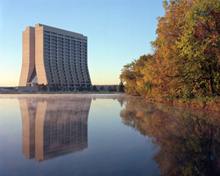
Thursday, November 11
9:00 a.m. Presentations to the PAC - Curia II
2:45 p.m. (NOTE TIME) Theoretical Physics Seminar - Curia II
Speaker: P. Skands, Fermilab
Title: A New Model for Parton Showers and the Underlying Event
3:30 p.m. DIRECTOR'S COFFEE BREAK - 2nd Flr X-Over
4:00 p.m. Accelerator Physics and Technology Seminar - 1 West
Speaker: A. Jansson, Fermilab
Title: Tevatron Ionization Profile Monitors
Friday, November 12
8:30 a.m. Presentations to the PAC - Curia II
3:30 p.m. DIRECTOR'S COFFEE BREAK - 2nd Flr X-Over
4:00 p.m. Joint Experimental Theoretical Physics Seminar - 1 West
Speaker: F. Halzen, University of Wisconsin, Madison
Title: Neutrino Astronomy at the South Pole: From AMANDA to IceCube
8:00 p.m. Fermilab Lecture Series - Auditorium
C. Haber, Lawrence Berkeley National Laboratory presents: Imaging the Voices of the Past:
Using Physics to Restore Early Sound Recordings
Tickets: $5
|

Thursday, November 11
Santa Fe Black Bean Soup
Marinara Meatball Sub $4.75
Stuffed Manicotti $3.75
Sauteed Liver and Onions $3.75
Baked Ham & Swiss on a Ciabatta Roll $4.75
Sausage & Sweet Onion Strombolis $3.25
Crispy Fried Chicken Ranch Salad $4.75
Wilson Hall Cafe Menu
Chez Leon
|




|
 |

E-cooling Wraps Up Its Shutdown Work
|
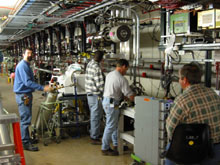
|
|
Technicians working on Electron Cooling project: (from left to right) Ron
Kellett, Kelly Hardin, Dan Assel, and Kermit Carlson. (Click on image for larger version.) |
|
|
For 12 weeks Fermilab employees have worked feverishly on installing accelerator
upgrades, fixing equipment and performing maintenance tasks. Slowly the accelerator
complex is coming back to life, and power testing for the Tevatron will begin
this weekend. The beam commissioning of the Main Injector is to begin on Saturday
after Thanksgiving (11/27), and the Tevatron and the Antiproton Source will
follow shortly thereafter.
Between now and Thanksgiving, members of the Electron Cooling project will
complete their work in the Main Injector tunnel. The work related to the
E-cool project determined the overall length of the shutdown: 13 weeks. "This
week, there are still about 20 people working on the E-cool project in the Main
Injector tunnel," said Jerry Leibfritz, who coordinates the work.
Much of the E-cool shutdown work left to be done is baking out the beam lines
to prepare for the best possible vacuum. Technicians are finishing the bake-out
of the two beam lines transporting electrons between the Pelletron accelerator
in the MI-31 building and the Electron Cooling section in the MI tunnel. Over
the next 10 days the project will bake out the 2 beam lines in the MI tunnel
itself.
"Each bake-out takes 4 to 5 days, and we expect to be done before Thanksgiving,"
said Leibfritz. "Getting the vacuum systems complete and leak-tight is very
rewarding. There is so much involved in building a leak-tight, ultra-high vacuum system."
The entire Ecool project includes the reassembly of the Pelletron accelerator and
its beam line. The section that runs through the MI tunnel, embracing the Recycler
storage ring, is about 70 feet long and had to be installed during the shutdown.
Before the installation, this section was a simple piece of beam pipe. Now it
contains 10 Electron Cooling tanks with solenoids, in which a continuous beam of electrons will
mix with a stream of antiprotons to cool the antiprotons. Below the cooling section is a
new beam line through which the electrons travel back to their source:
the Pelletron in the MI-31 building adjacent to the tunnel. Commissioning of the
Pelletron will begin in February, and cooling of antiprotons should
begin in late 2005.
|
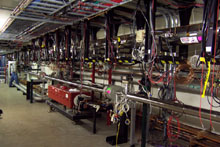
|
|
The MI tunnel near MI-31. Top (inside black support structure): Recycler
beam line with cooling tanks. Middle (above red magnet): return line for
electrons. Bottom: MI beam line with magnet (red), with parts of the beam
pipe removed. (Click on image for larger version.) |
|
URA Scholarships Require SAT Test Scores
|
|
|
|
Every year, the Universities Research Association awards a number of scholarships to children
of regular, full-time Fermilab employees. URA scholarships are awarded on
the basis of SAT scores.
Scholarship candidates must be high school seniors who will begin a four-year
college degree program in the fall. The maximum amount of the scholarship
is $4000 for tuition and fees, and is renewable for four years for students
in good academic standing.
Applications are available online
January 1 through March 1. Scholarships will be awarded in early April.
Questions about the program may be directed to Jeannelle Smith of Human Resources,
x4367.
|
Fermilab Lecture Series Tomorrow Night
Carl Haber of LBNL Presents "Imaging the Voices of the Past:
Using Physics to Restore Early Sound Recordings"
Sound was first recorded and reproduced by Thomas Edison in 1877. Until
about 1950, when magnetic tape use became common, most recordings were
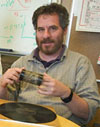
|
|
Carl Haber |
made on mechanical media such as wax, foil, shellac, lacquer, and plastic.
Some of these older recordings contain material of great historical value or
interest but are damaged, decaying, or now considered too delicate to
play.
Carl Haber of LBNL is an expert on a new technique to rescue these irreplaceable
treasures. He will discuss the history of sound recording and the issues
faced by archives and libraries as they strive to preserve, and create
greater access to, these valuable materials.
Join Dr. Haber on Friday, November 12, 2004 at 8 p.m. in Fermilab's Ramsey
Auditorium.
A video preview of this topic is available online. Look for the
Discovery Channel's story about the work of Dr. Haber.
more information
|

FYI: AIP Bulletin of Science Policy News, November 9, 2004
Trends in First-Year Graduate Physics & Astronomy Students
In 2003, the number of first-year physics and astronomy graduate students reached the highest level since 1994, according to a report by the American Institute of Physics' Statistical Research Center. The October 2004 report also highlights an upturn in the number of US citizens who are starting graduate school in physics and astronomy, while the numbers of students from China and India continue to grow as well.
Read more
|
|
 |

Sampling Jet Flavor on the Way to the Higgs
|
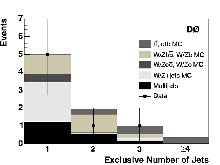
|
|
The number of events having a W-boson candidate plus exactly one, two,
three, and four or more jets. To enter this plot the event must have
at least one jet that has been b-tagged by both secondary vertex tagging
and soft-lepton tagging algorithms. (Click on image for larger version.) |
|
|
Precision measurements of top-quark properties and searches for new
physics are large parts of the physics program at Fermilab's
Tevatron. These studies depend largely on the accurate predictions of
their underlying Standard Model background compositions. In
particular, the ongoing efforts to find evidence for a Standard Model Higgs boson
are very sensitive to small fluctuations in background rates.
Many signals of new phenomena and the search for the Higgs require
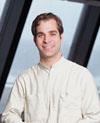
|
Chris Tully (Princeton)
has examined the
heavy flavor
content
of
W plus jet
events. |
identification of heavy flavor content, such as b quarks, in events.
Heavy-flavor jet tagging uses unique properties of hadrons containing
heavy flavor quarks to distinguish them from hadrons containing only
light-flavor quarks (u,d,s). Complicating this picture, evidence for
anomalous production of heavy-flavor quarks (t,b,c) in association with
W bosons was reported in Run I. Using both secondary vertex tagging and
soft-lepton tagging, the CDF study suggested there was an unusually
large number of events containing a W boson and two or three jets in
which at least one of the jets was simultaneously tagged by two
different heavy-flavor jet tagging algorithms.
Secondary vertex tagging relies on displaced vertices formed by the
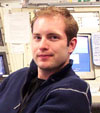
|
Wade Fisher
(Princeton) worked on
this
analysis as
part
of his Ph.D. thesis. |
tracks of particles produced in the decays of long-lived particles,
such as B- or D-mesons. Soft-lepton tagging keys on low transverse
momentum leptons inside jets, arising from the semileptonic decays of
heavy-flavor quarks. Lacking tracking detectors with sufficient
resolution, the DZero experiment was unable to test this observation in
Run I data.
The Run II upgrade of the DZero detector has provided the means of testing
this anomalous result. In a selection of leptonic W-boson
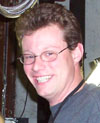
|
|
Rob McCroskey |
decays, we have evaluated the heavy-flavor content of associated jets.
We compared the predictions of the expected SM processes to data in
events with a W boson and at least one jet tagged with both secondary
vertex and soft-lepton tagging algorithms. In this selection, we find
no excess of events beyond Standard Model predictions, this increases our
confidence that rare backgrounds to particle searches are becoming
better understood.
|
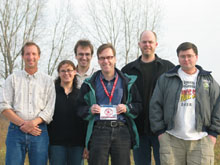
|
|
The L1 muon triggering crew from Arizona and Boston University:
(above) Rob McCroskey (Arizona), (left to right) Ken Johns, Susan Burke,
and Jeff Temple (Arizona), John Butler (Boston), Stefan Anderson,
(Arizona) and Jason Kasper (Boston) has been responsible for this highly
efficient system. (Click on image for larger version.) |
|
Result of the Week Archive
|


Wanted: Einstein Materials
From Beanie Babies to coffee mugs, you can find Einstein's face on just
about anything these days, and symmetry magazine wants to know what
kinds of Einstein materials you have. Whether it's a t-shirt or even an
action figure, send a photo to Elizabeth Clements
or drop by Public Affairs to show off your collection by November 19.
Items may be borrowed in order to be photographed for an upcoming issue
of symmetry.
Brown Bag Seminar Next Week
Wellness Works will present a Brown Bag Seminar "Parenting Through the Holidays"
on Wednesday, November 17 from noon to 1:00 pm in Curia II.
Join us for ideas about
making the holidays more enjoyable for parents and children and
dealing successfully with the stresses of the season.
Power Outage News
Wilson Hall
November 14 – The power will be off to Wilson Hall for ten hours on Sunday,
beginning at 7 AM.
Upcoming Activities
|
|



